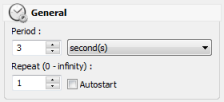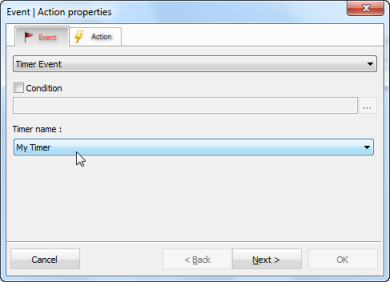User Guide > Working with objects and properties > Types of objects > Timers
Timer is an object that allows you to execute actions at some time moment or periodically. This can be useful to display periodic reminders to a user, execute some application with a pause to let other processes finish their work and so on.
The timer object can be added to a project, a window, a page or a group. Right-click the object in the Project Panel and select "Add | Timer object". In order to edit properties of a timer, select it and specify timer period, repeat count and the time unit in the Properties Panel.

Use the “Autostart” option if you want the timer to start ticking as soon as its parent object becomes first initialized. For the project timer, the autostart timing is the application startup; for the window it is the moment the window is first shown on the screen and so on.
Typically, a timer stops when it goes through the specified number of repeats. If zero is provided as the repeat count, the timer works until stopped. You can start or stop any timer at any moment using the "Timer actions" category in Action properties of an object.
Using Timer to Execute Actions
The Timer Event allows you to execute actions when the corresponding timer object triggers. The Timer Event is available for projects, windows, pages and groups. To create a timed event, first, select the object in the Project Panel, then switch to the Actions section in the Properties Panel. Click “Add Action”. Choose the Timer Event in the event dropdown list, then select the Timer name of the timer that should trigger the action.

After assigning an action, that action will be executed every time the timer triggers.